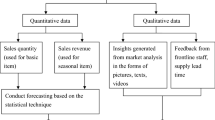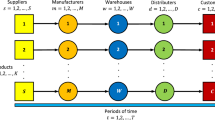Abstract
Due to rapid technological innovation and global competitiveness, the demand of many fashion-typed products usually decline significantly over time. A retailer facing such a market can employ replenishment strategies to increase its profit. This study, from the perspective of the retailer in a two-echelon supply chain, develops the optimal replenishment strategy for products experiencing deterioration, continuous decrease in market demand and price changes. This model help determine the optimal product life for products. Numerical examples are systematically conducted to verify the performances of the proposed model.







Similar content being viewed by others
References
Akella, R., & Kumar, P. R. (1986). Optimal control of production rate in a failure prone manufacturing system. IEEE Transactions on Automatic Control, AC-31, 116–126.
Bacsi, Z., & Vizvári, B. (1999). Modelling chaotic behaviour in agricultural prices using a discrete deterministic nonlinear price model. Annals of Operations Research, 89, 125–148.
Bakker, M., Riezebos, J., & Teunter, H. R. (2012). Review of inventory systems with deterioration since 2001. European Journal of Operational Research, 221(2), 275–284.
Chen, M. S., & Chu, M. C. (2001). The analysis of optimal price control model in matching problem between production and sales. Asia-Pacific Journal of Operational Research, 18, 131–148.
Chen, W., Feng, Q., & Seshadri, S. (2012). Sourcing from suppliers with random yield for price-dependent demand. Annals of Operations Research. doi:10.1007/s10479-011-1046-5.
Dave, D. S., Fitzpatrick, K. E., & Baker, J. R. (1996). An advertising-inclusive production lot size model under continuous discount pricing. Computers & Industrial Engineering, 30, 147–159.
Doorman, G., & Nygreen, B. (2003). Market price calculations in restructured electricity markets. Annals of Operations Research, 124, 49–67.
Feng, Y., & Gallego, G. (1995). Optimal stopping times for end of season sales and optimal stopping times for promotional fares. Management Science, 41, 1371–1391.
Ghare, P. M., & Schrader, S. F. (1963). A model for an exponentially decaying inventory. Journal of Industrial Engineering, 14, 238–243.
Goyal, S. K., & Giri, B. C. (2001). Recent trends in modeling of deteriorating inventory. European Journal of Operational Research, 134, 1–16.
Hsu, P. H., Wee, H. M., & Teng, H. M. (2010). Preservation technology investment for deteriorating inventory. International Journal of Production Economics, 124(2), 388–394.
Jørgensen, S., Kort, P. M., & Zaccour, G. (1999). Production, inventory, and pricing under cost and demand learning effects. European Journal of Operational Research, 117, 382–395.
Lin, P.-C. (2008). Optimal pricing, production rate, and quality under learning effects. Journal of Business Research, 61(11), 1152–1159.
Lin, Y. S., Yu, J. C. P., & Wang, K.-J. (2009). An efficient replenishment model of deteriorating items for a supplier-buyer partnership in hi-tech industry. Production Planning & Control, 20, 431–444.
Montgomery, D. C. (2005). Design and analysis of experiments (6th ed.). Hoboken: Wiley.
Ouyang, L.-Y., Teng, J.-T., Goyal, S. K., & Yang, C.-T. (2009). An economic order quantity model for deteriorating items with partially permissible delay in payments linked to order quantity. European Journal of Operational Research, 194, 418–431.
Petruzzi, N. C., & Dada, M. (1999). Pricing and the newsvendor problem: a review with extensions. Operations Research, 47, 183–194.
Rosenblatt, M. J., & Lee, H. L. (1986). Economic production cycles with imperfect production processes. IIE Transactions, 18, 48–55.
Shemesh, E., Rabinowitz, G., & Mehrez, A. (1999). Optimal capacity and operation of deteriorating chemical production service facilities. Annals of Operations Research, 91, 205–225.
Shinn, S. W., & Hwang, H. (2003). Optimal pricing and ordering policies for retailers under order-size-dependent delay in payments. Computers & Operations Research, 30, 35–50.
Singer, M., Donoso, P., & Noguer, J. L. (2005). Optimal planning of a multi-station system with sojourn time constraints. Annals of Operations Research, 138, 203–222.
Upasani, A., & Uzsoy, R. (2008). Incorporating manufacturing lead times in joint production-marketing models: a review and some future directions. Annals of Operations Research, 161, 171–188.
Wang, K.-J., Lin, Y. S., & Yu, J. C. P. (2011). Optimizing inventory policy for products with time-sensitive deteriorating rates in a multi-echelon supply chain. International Journal of Production Economics, 130, 66–76.
Wee, H. M. (1999). Deteriorating inventory model with quality discount, pricing and partial backordering. International Journal of Production Economics, 59, 511–518.
Yang, P. C., & Wee, H. M. (2006). A collaborative inventory system with permissible delay in payment for deteriorating items. Mathematical and Computer Modelling, 43, 209–221.
Yang, P. C., Wee, H. M., & Yu, J. C. P. (2007). Collaborative pricing and replenishment policy for hi-tech industry. Journal of the Operational Research Society, 58, 894–900.
You, P.-S. (2007). Optimal times of price reductions for an inventory model with partial backorder and vertical shift demand. RAIRO. Operations Research, 41, 35–47.
Yu, J. C. P., Lin, Y. S., & Wang, K.-J. (2012). Coordination-based inventory management for deteriorating items in a two-echelon supply chain with profit sharing. International Journal of Systems Science. doi:10.1080/00207721.2012.659701.
Acknowledgements
The authors gratefully acknowledge the valuable comments and suggestions of the anonymous referees. This work is partially supported by the National Science Council of the Republic of China to the first author.
Author information
Authors and Affiliations
Corresponding author
Appendices
Appendix A: Proof of Proposition 1
The analysis of production (Fig. 1) is valid only if the condition \(I_{0}^{S}(t_{0}) \ge q_{1}^{*}\) is satisfied. From (20),
Then
Therefore,
Similarly, from (21), for the initial period of production is \(t_{0} = \frac{1}{\theta} \ln[ \frac{p_{0}}{p_{0} - q_{1}^{*}\theta} ]\), the following condition is satisfied: \(t_{0} \le\frac{1}{\theta} \ln[ \frac{P_{0}}{P_{0} - q_{1}^{*}\theta} ]\).
Appendix B: Proof of Proposition 2
Assume that a production rate, \(p'_{i}\), is larger than p i , the value of Eq. (21).
The supplier’s revenue is the same because the redundant products will not be sold
Then the production and storage cost will increase by



Therefore, the supplier’s total profit is decreased to

This ends the proof.
Appendix C: Design of experiments
Run | Basic design | TP S | TP R | |||||||||
|---|---|---|---|---|---|---|---|---|---|---|---|---|
h A | k B | O r C | U D | ν E | ρ F=ABCD | η G=ABCE | ω H=ABDE | A J=ACDE | θ K=BCDE | |||
1 | – | – | – | – | – | + | + | + | + | + | 62,865 | 1,750,296 |
2 | – | – | – | – | + | + | – | – | – | – | 161,944 | 163,802 |
3 | – | – | – | + | – | – | + | – | – | – | 29,376 | 102,998 |
4 | – | – | – | + | + | – | – | + | + | + | 102,573 | 1,060,363 |
5 | – | – | + | – | – | – | – | + | – | – | 41,103 | 559,582 |
6 | – | – | + | – | + | – | + | – | + | + | 105,557 | 78,236 |
7 | – | – | + | + | – | + | – | – | + | + | 100,131 | 383,125 |
8 | – | – | + | + | + | + | + | + | – | – | 61,594 | 805,549 |
9 | – | + | – | – | – | – | – | – | + | – | 113,713 | 163,627 |
10 | – | + | – | – | + | – | + | + | – | + | 84,735 | 474,552 |
11 | – | + | – | + | – | + | – | + | – | + | 14,451 | 1,169,658 |
12 | – | + | – | + | + | + | + | – | + | – | 178,344 | 245,895 |
13 | – | + | + | – | – | + | + | – | – | + | 128,364 | 238,772 |
14 | – | + | + | – | + | + | – | + | + | – | 141,427 | 1,737,788 |
15 | – | + | + | + | – | – | + | + | + | – | 25,695 | 835,875 |
16 | – | + | + | + | + | – | – | – | – | + | 53,620 | 51,935 |
17 | + | – | – | – | – | – | – | – | – | + | 71,341 | 105,999 |
18 | + | – | – | – | + | – | + | + | + | – | 130,025 | 874,818 |
19 | + | – | – | + | – | + | – | + | + | – | 28,660 | 2,033,061 |
20 | + | – | – | + | + | + | + | – | – | + | 112,553 | 159,524 |
21 | + | – | + | – | – | + | + | – | + | – | 205,224 | 371,875 |
22 | + | – | + | – | + | + | – | + | – | + | 93,536 | 979,951 |
23 | + | – | + | + | – | – | + | + | – | + | 13,192 | 453,066 |
24 | + | – | + | + | + | – | – | – | + | – | 77,834 | 80,191 |
25 | + | + | – | – | – | + | + | + | – | – | 36,729 | 993,226 |
26 | + | + | – | – | + | + | – | – | + | + | 236,794 | 250,660 |
27 | + | + | – | + | – | – | + | – | + | + | 49,100 | 159,321 |
28 | + | + | – | + | + | – | – | + | – | – | 66,838 | 587,698 |
29 | + | + | + | – | – | – | – | + | + | + | 64,928 | 1,024,148 |
30 | + | + | + | – | + | – | + | – | – | – | 72,690 | 50,371 |
31 | + | + | + | + | – | + | – | – | – | – | 60,423 | 247,587 |
32 | + | + | + | + | + | + | + | + | + | + | 97,107 | 1,464,150 |
Rights and permissions
About this article
Cite this article
Wang, KJ., Lin, YS. Optimal inventory replenishment strategy for deteriorating items in a demand-declining market with the retailer’s price manipulation. Ann Oper Res 201, 475–494 (2012). https://doi.org/10.1007/s10479-012-1213-3
Published:
Issue Date:
DOI: https://doi.org/10.1007/s10479-012-1213-3




